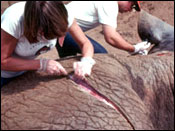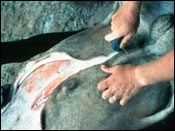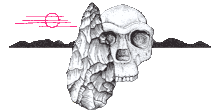Experimental Manufacture
and Use of Stone Tools
How were early stone tools made, and how could they have been used? Stone Age Institute researchers Nicholas Toth and Kathy Schick have devoted three decades of study to the experimental manufacture and use of stone tools. This is important research, as it takes archaeology out of the armchair and into direct investigation of the role tools have played in human evolution and adaptation. Such experimental studies can show us the possible techniques and strategies employed by prehistoric tool-makers. Importantly, they also reveal the types of tool-making debris associated with different manufacturing activities, so that we can identify these at archaeological sites. This gives us powerful means to interpret prehistoric artifactual materials from excavated sites, allowing us to understand tool-making techniques and abilities among prehistoric humans in the distant past.
Such experiments can give us important insights into early hominid tool-makers. They can provide valuable information about stages of manufacture represented at an archaeological site, levels of skill and expertise in early tool-makers, handedness in early human populations, use of different parts of sites for different activities, possible rules and conventions in making tools (and an early sense of ‘style’ and possibly even aesthetics in early stone tools), and decision-making in choosing raw materials for tools.
Experiments in using stone tools address essential functional and adaptive questions: why did early humans start making tools, and what role did these implements serve in their lives and adaptation? By using experimental stone tools for a range of activities, researchers can directly investigate which tools are best for which activities. They can also look for relationships between the form of an artifact and its function.
Stone Age Institute researchers Travis Pickering, Charles Egeland, Nicholas Toth, and Kathy Schick have engaged in a variety of experimental studies of processing carcasses of animals that had died of natural causes. Such functional experiments can also help to identify other types of evidence that can indicate artifact use, such as edge damage and wear patterns on the edges of stone tools; fracture patterns; cut-marks, chop-marks, and hammerstone percussion and abrasion on animal bones; and organic residues on ancient stone tools. The identification of such prehistoric "smoking barrels" of tool use is a high priority in Stone Age research.



